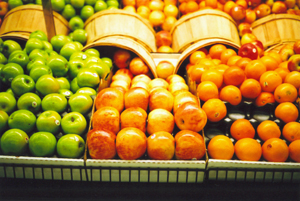 This winter, Wal-Mart announced their plans to bring more local produce to their stores across the United States. The announcement is perhaps one of the most visible indications that the local foods movement has hit the mainstream, as it gains followers for both economic and environmental reasons. Yet it is necessary to approach such an announcement with a dose of skepticism when it comes from a company that seems to be driven so heavily by the bottom line.
This winter, Wal-Mart announced their plans to bring more local produce to their stores across the United States. The announcement is perhaps one of the most visible indications that the local foods movement has hit the mainstream, as it gains followers for both economic and environmental reasons. Yet it is necessary to approach such an announcement with a dose of skepticism when it comes from a company that seems to be driven so heavily by the bottom line.
Some have criticized Wal-Mart’s new policy to promote local food as little more than a marketing ploy, and have accused the company of re-labeling products they already procure locally. However, in a recent Wall Street Journal article, Wal-Mart says that the consumer demand for local produce is aligned with cost-savings objectives. Wal-Mart, like many other national chains, says that they can save money on transportation by purchasing food near to its point of sale and also cut down on waste due to food spoilage. In a press release, the company announced that they hope to source up to nine percent of all produce locally.
Many grocery stores also spotlight their local produce, although the definition of “local” is depends on the store. Here is a look at how some of the major grocery chains defined local produce.
- A&P: grown within New York and New Jersey, according to a company representative
- Kroger (and subsidiaries): the term “local” can refer to produce grown in the same state or region
- Safeway: produce is only local if it can reach the store in less than an eight hour drive
- Sweetbay Super Market: Within the state
- Publix: Local produce comes from the five states within which the stores are located (Florida, Georgia, Tennessee, South Carolina and Alabama)
- Walmart: Grown within 450 miles of distribution centers, but only highlights fruits and vegetables as local if they come from the state in which they are sold
- Whole Foods: Defines local foods as anything that have traveled less than 7 hours by car or truck
- Wegmans: At least within the state
An important aspect of the local food movement is about increasing the transparency of food systems: consumers want to know where their food comes from. I was surprised to find many grocery stores express a commitment to local produce, yet fail to qualify these statements. For example, Wegmans has a website page dedicated to explaining the importance of food miles, yet offers no hard definition for what the maximum number of food miles is acceptable for a food to be labeled “locally grown.” On the other hand, Wegmans has a twitter account dedicated to tweeting out the arrival of local produce to their stores, often indicating where the food in coming from. A tweet at this account provided me with the definition listed above.
Overall, it seems that these companies generally have very reasonable definitions of local. Kroger’s definition sounds the most vague, but it also has many different subsidiary chains. It should also be noted that although this list is not comprehensive, some grocery stores could not be included because they do not have a local produce policy whatsoever, such as Aldi and Target.
 Once I began digging for these definitions and talking to grocery store representatives, I quickly became very aware of the challenges facing stores that wish to stock their shelves with local produce. “Customers have grown to expect products year-round,” explains Maria Brous, Director of Media & Community Relations at Publix. She explains that Publix strives to stock produce from their five states of operation first, but that this simply isn’t always possible. “Product is not available year-round in the same place, and sometimes product is not available in a certain area at all.”
Once I began digging for these definitions and talking to grocery store representatives, I quickly became very aware of the challenges facing stores that wish to stock their shelves with local produce. “Customers have grown to expect products year-round,” explains Maria Brous, Director of Media & Community Relations at Publix. She explains that Publix strives to stock produce from their five states of operation first, but that this simply isn’t always possible. “Product is not available year-round in the same place, and sometimes product is not available in a certain area at all.”
Even for the grocery stores that are the most dedicated to locally grown produce, it’s a challenge to stock exclusively from local farms. Ellwood’s Thompson’s Market, an independent grocery store in Richmond, VA, works to source their produce from within a 100-mile radius of the store. “Eighty percent of our greens and things might be local for two weeks,” say Paige Bishop. “But then all of a sudden they’re sold out of that crop and then we’re sourcing some things organically instead of locally.”
Although local produce may only represent a fraction of the nation’s grocery purchases, the benefit to the local economies can be great. Independent We Stand, a movement of business owners who support buying local, has calculated that if every family in Wichita, KS spent $10.00 at a local business, over $19,000,000 would be re-invested into the local economy (learn more about their economic impact calculator here). “The more that you buy local, the more that money is going back into the community,” says Bishop.
Also Read:
